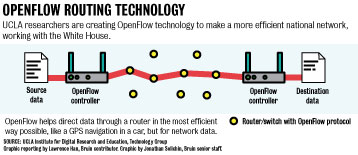If UCLA researchers wanted to move three terabytes of data ““ equivalent to about a billion typewritten pages ““ to a lab across campus, they would transfer a small portion of that information onto a USB and physically walk the drive over.
They might have to repeat this, again and again, until all the data was moved, a process that could take days, even months.
Finding a more efficient way to store and transfer information is the goal of a new UCLA project.
As part of a White House initiative under the National Science Foundation, UCLA researchers will implement technology that creates faster Internet, and build data-sharing Web applications that use that network, enabling them to run 100 times quicker than on a typical wireless connection.
Applications developed through the program could, for example, establish a stronger Wi-Fi signal that would quickly send important information such as medical records from the hospital to a patient, said Mario Gerla, a professor of computer science at UCLA involved in research for the project.
The government initiative, known as the U.S. Ignite program, aims to develop ultra-fast broadband and software-defined wireless Internet networks that can run sophisticated applications geared to areas such as health care, education and public safety. Late last month, UCLA was one of 14 universities selected to participate in the program.
U.S. Ignite plans to develop at least 60 next-generation Internet applications within the next five years for societal benefit, according to a statement on the U.S. Ignite website.
“As we move forward in this century, how to store, use and share data in real time becomes more strained,” said Warren Mori, executive director of the Institute for Digital Research and Education.
Now, with the U.S. Ignite initiative reaching UCLA, researchers are searching for solutions to this problem.
“The only way to handle this is to find technology to make data flow faster or to open a bigger “˜pipe,'” said Bill Labate, director of the UCLA Institute for Digital Research and Education, Research Technology Group.
At the heart of the U.S. Ignite project is OpenFlow, essentially technology that can intelligently funnel large amounts of data through the fastest, most efficient route on a network, Labate said.
UCLA will implement OpenFlow as an overlay to the Campus Backbone network, or the central wireless Internet network that connects all of the different ones at UCLA.
“OpenFlow will allow (users) to send greater amounts of information faster and more effectively through existing networks,” Mori said.
As researchers transfer terabytes worth of data using OpenFlow, others who log on to UCLA’s wireless Internet network will not feel the difference. OpenFlow allows researchers to conduct advanced network experiments without disturbing other users within the network, Labate said.
At this time, only a few buildings at UCLA, such as Engineering IV and V, MSA, the California NanoSystems Institute, the Gonda Center and the UCLA Performance Optimized Datacenter will be used as a test bed for OpenFlow technology, said Gerla.
Gerla said graduate students in computer science and members of the Institute for Digital Research and Education will be able to work with the enhanced Campus Backbone Network for research once the initial experimentation phase is completed.
Computer science researchers are also working with OpenFlow technology to create applications that will help transfer data on a smaller scale. For example, campus-owned vehicles ““ such as those used by parking enforcement officials ““ will be able to download data from the Internet anywhere on campus. Officials could look up license plate records from a database on the Web, for instance.
UCLA researchers were given a two-year grant for the project, which will run until the end of 2014, Labate said.
UCLA was picked for the initiative because of the school’s previous work in similar projects, Gerla said.
For example, UCLA researchers were part of the National Science Foundation’s Global Environment for Network Innovations, a project that experimented with Internet, broadband and other networking concepts such as OpenFlow to find more efficient ways of data transfer.
Future goals at UCLA within the frame of the U.S. Ignite project include maintaining both Wi-Fi and 3G connections open at the same time, and combining the two streams for extra security, Gerla said.
“The advantage of having (multiple) connections is that when one is poor, another will pick it up,” Gerla said.
He added that he hopes the innovations will allow students and faculty to seamlessly access the Internet for resources wherever on campus they may be.
At this point, the private use of OpenFlow is not practical, Labate said. “You need special equipment. The largest part of this grant is network research equipment.”
Other potential advancements in data flow could have a wider use for society, such as self-driving cars, Mori said.
Cars that drive based on directions delivered by data could become a reality with OpenFlow technology and the research conducted through U.S. Ignite, he added.
